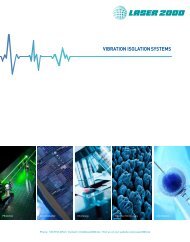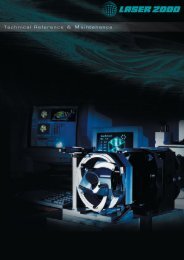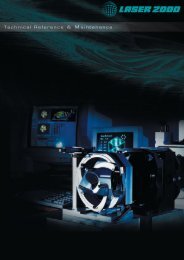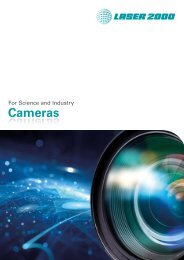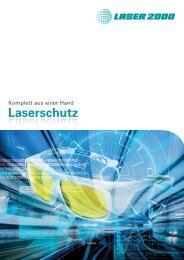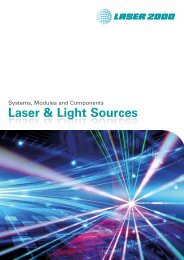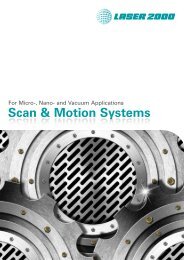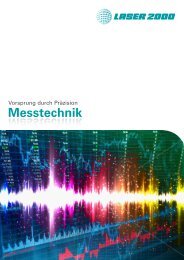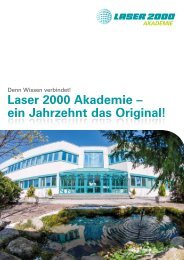Semrock Master Catalog 2018
Semrock Master Catalog 2018
Semrock Master Catalog 2018
You also want an ePaper? Increase the reach of your titles
YUMPU automatically turns print PDFs into web optimized ePapers that Google loves.
Fluorophores<br />
Single-band<br />
Sets<br />
Multiband<br />
Sets<br />
Cubes Laser<br />
Sets<br />
NLO<br />
Filters<br />
TECHNICAL NOTE<br />
You Can Clean <strong>Semrock</strong> Optical Filters!<br />
<strong>Semrock</strong> manufactures the most durable optical filters available.<br />
However, it is important to note that while all optical components<br />
should be handled with care, soft-coated filters are especially<br />
susceptible to damage by handling and cleaning. Fortunately,<br />
<strong>Semrock</strong> supplies only hard-coated filters, so all of <strong>Semrock</strong>’s filters<br />
may be readily cleaned using the following recommended method.<br />
The following are recommended to properly clean your filters:<br />
• Unpowdered laboratory gloves – prevent finger oils from<br />
contaminating the glass and keep solvents from contacting skin;<br />
• Eye protection – critical for avoiding getting any solvent in your eyes;<br />
• Compressed air – clean, filtered laboratory compressed nitrogen<br />
or air is ideal, but “canned” compressed air or even a rubber “bulb<br />
blower” in a relatively clean environment is acceptable;<br />
• Lint-free swab – cotton-based swabs work best;<br />
• Lens cleaning tissue – lint-free tissue paper is also acceptable;<br />
• Cleaning solvent – we recommend Isopropyl Alcohol (IPA)<br />
and/or Acetone. Care should be taken when handling these<br />
solvents, especially to avoid ingestion.<br />
1. Blow off contaminants. Many contaminants are loosely attached to<br />
the surface and can be blown off. Using laboratory gloves, hold the<br />
filter in one hand and aim the air stream away from the filter. Start<br />
the air stream using a moderate air flow. Maintaining an oblique<br />
angle to the part – never blow straight on the filter surface – now<br />
bring the air stream to the filter, and slowly move it across the<br />
surface. Repeat until no more loose particles are disappearing.<br />
2. Clean filter. If dust or debris remains, it is probably “stuck” to<br />
the surface and must be removed with mechanical force and/or<br />
chemical action. Create a firm but “pointy” tip with the lint-free<br />
wipe or lens tissue by folding it multiple times into a triangular<br />
shape or wrapping it around a swab. Lint-free swabs may also be<br />
used directly in place of a folded wipe. Moisten the wipe or swab<br />
with either IPA or Acetone, but avoid too much excess solvent.<br />
The key to cleaning<br />
the optic is to maintain<br />
one continuous motion<br />
at as constant a speed<br />
as possible. Some<br />
people prefer to<br />
clean using a “figure<br />
8” pattern while others<br />
choose to start in the<br />
center of the part and wipe<br />
outward in a spiral pattern.<br />
Do not stop the wipe on<br />
the surface – keep the wipe<br />
moving at a constant speed, lifting the moving wipe off the part<br />
when you reach the end of the pattern.<br />
3. Inspect filter. Use a room light or any bright light source to<br />
inspect the optic to ensure that it is clean. Tip, tilt, and rotate<br />
the optic while viewing it as close to your eye as you can focus. If<br />
contamination remains, start with a brand new wipe or swab and<br />
repeat step 2 above.<br />
4. Repeat steps 1 – 3 for the other side of the filter if<br />
contamination exists.<br />
Precautions for Edge Blackened Filters<br />
For <strong>Semrock</strong> edge blackened filters, the above procedures<br />
can be used with the following precautions.<br />
• Only IPA or water based cleaning solutions can be used.<br />
• Acetone, Methanol, and other chemical solutions should be<br />
avoided as they will damage the edge blackening material.<br />
• Aggressive wiping of the blackened edge should be avoided.<br />
Note: IPA and Acetone each have pros and cons, so choose the solvent that<br />
works best for you after trying both.<br />
Watch the video tutorial on how to clean<br />
your optical filters at www.semrock.com<br />
Individual<br />
Filters<br />
SEARCHLIGHT<br />
Dichroic<br />
Beamsplitters<br />
Tunable<br />
Filters<br />
SearchLight allows fluorescence microscope users and optical instrument designers to predetermine the optimal fluorophore,<br />
light source, detector, and optical filter combinations for their microscope or system. By removing the guesswork and hours of<br />
searching multiple sources for spectral data, SearchLight users will be able to eliminate trial-and-error headaches and work more<br />
efficiently. Users may select from an extensive collection of preloaded spectra or upload their own spectral data in this free and<br />
openly accessible tool. Users can also save and share their data securely.<br />
Share: The share feature within SearchLight<br />
enables collaboration across researchers,<br />
engineers, companies and institutions by<br />
creating a unique URL link to the session which<br />
can be emailed to a colleague or collaborator.<br />
Use SearchLight now. Save time later. Try it at:<br />
http://searchlight.semrock.com<br />
More<br />
42



